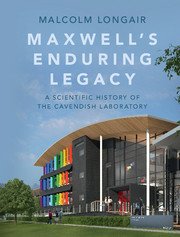Book contents
- Frontmatter
- Dedication
- Contents
- Preface
- Acknowledgements
- Part I To 1874
- Part II 1874 to 1879
- Part III 1879 to 1884
- Part IV 1884 to 1919
- Part V 1919 to 1937
- Part VI 1938 to 1953
- Part VII 1953 to 1971
- Part VIII 1971 to 1982
- 16 The Pippard era: a new Laboratory and a new vision
- 17 The Pippard era: radio astronomy, high–energy physics and laboratory astrophysics
- 18 The Pippard era: condensedmatter physics
- Part IX 1984 to 1995
- Part X 1995 to present
- Appendix The evolution of the New Museums site
- Notes
- References
- Author index
- Subject index
18 - The Pippard era: condensedmatter physics
from Part VIII - 1971 to 1982
Published online by Cambridge University Press: 05 July 2016
- Frontmatter
- Dedication
- Contents
- Preface
- Acknowledgements
- Part I To 1874
- Part II 1874 to 1879
- Part III 1879 to 1884
- Part IV 1884 to 1919
- Part V 1919 to 1937
- Part VI 1938 to 1953
- Part VII 1953 to 1971
- Part VIII 1971 to 1982
- 16 The Pippard era: a new Laboratory and a new vision
- 17 The Pippard era: radio astronomy, high–energy physics and laboratory astrophysics
- 18 The Pippard era: condensedmatter physics
- Part IX 1984 to 1995
- Part X 1995 to present
- Appendix The evolution of the New Museums site
- Notes
- References
- Author index
- Subject index
Summary
Physics and chemistry of solids
The Physics and Chemistry of Solids (PCS) Group continued to expand its areas of interest, as indicated in Table 16.1. While Tabor continued as Head of Group until his retirement, Yoffe played a key role in broadening the experimental activities of the group. As he states in his memoir of Nevill Mott,
[Mott] was to have a great influence on my research activities and career …. I did not collaborate directly with him on any specific topic, since this would not have worked out, given our approaches. But through contact with him, I moved into areas such as semiconductors, low-dimensional solids, amorphous solids and metal-insulator transitions. (Yoffe, 1998)
Much of the research was at the interface between physics and chemistry. Yoffe's research had originally been concerned with the physics of explosive materials, but now he acted as the leader for the activities which would inspire important initiatives in the Laboratory, many of them the result of Mott's advocacy. The PCS Group had grown to be the largest in the Laboratory and proved to be a magnet for many of the brightest young researchers – Yoffe's graduate students included Richard Friend, Yao Liang and John Wilson, while among John Field's students was the successful entrepreneur Hermann Hauser.
Mott and amorphous materials
Undoubted highlights of the PCS programme were the studies of amorphous thin films of metals and semiconductors and of glasses using a variety of electrical and optical techniques. This work was greatly stimulated by Mott's pioneering activities on the electronic structure of magnetic and disordered systems, especially amorphous semiconductors, which, following his ‘retirement’, he carried out in the PCS Group. He was awarded the 1977 Nobel Prize in Physics for his work on amorphous materials.
In crystalline silicon, the crystal structure is very regular. Looking down any of the bond directions, the atoms display tetragonal symmetry and this structure is repeated throughout the crystal, with each atom being bonded to four others. The bonds are all of the same length and at the same angle to one another, forming rings of six atoms (Figure 18.1(a)). In amorphous materials such as glasses or amorphous silicon, the structure is irregular and there is no such symmetry.
- Type
- Chapter
- Information
- Maxwell's Enduring LegacyA Scientific History of the Cavendish Laboratory, pp. 436 - 456Publisher: Cambridge University PressPrint publication year: 2016



